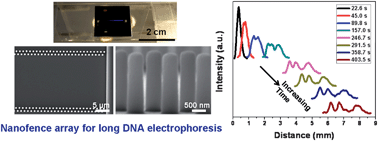DNA electrophoresis in a nanofence array†
Abstract
We present the design and implementation of an oxidized silicon “nanofence array” for long DNA

* Corresponding authors
a
Department of Chemical Engineering and Materials Science, University of Minnesota – Twin Cities, 421 Washington Ave SE, Minneapolis, MN 55455, USA
E-mail:
dorfman@umn.edu
Fax: + 1-612-626-7246
Tel: + 1-612-624-5560
We present the design and implementation of an oxidized silicon “nanofence array” for long DNA

 Please wait while we load your content...
Something went wrong. Try again?
Please wait while we load your content...
Something went wrong. Try again?
S. Park, D. W. Olson and K. D. Dorfman, Lab Chip, 2012, 12, 1463 DOI: 10.1039/C2LC00016D
To request permission to reproduce material from this article, please go to the Copyright Clearance Center request page.
If you are an author contributing to an RSC publication, you do not need to request permission provided correct acknowledgement is given.
If you are the author of this article, you do not need to request permission to reproduce figures and diagrams provided correct acknowledgement is given. If you want to reproduce the whole article in a third-party publication (excluding your thesis/dissertation for which permission is not required) please go to the Copyright Clearance Center request page.
Read more about how to correctly acknowledge RSC content.
 Fetching data from CrossRef.
Fetching data from CrossRef.
This may take some time to load.
Loading related content
